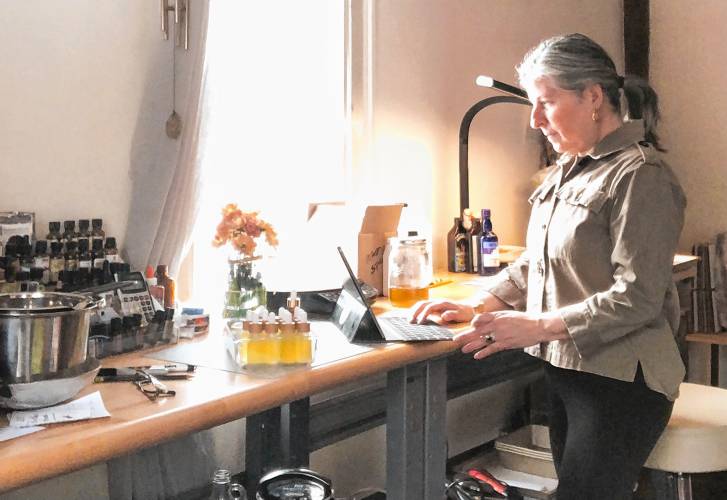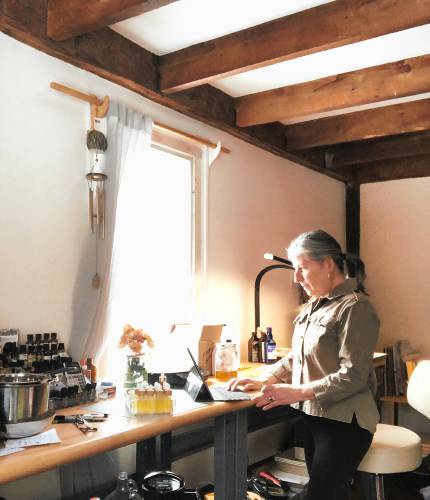BUSINESS QUARTERLY: Internet broadens work-from-home opportunities
|
Published: 01-23-2024 9:04 AM
Modified: 01-25-2024 9:06 AM |
Lori Finn of Greenfield’s commute to work is about as far as she needs to walk to her home office – a far cry from the 120 miles it would take for her to drive to Russell Sage College in Troy, N.Y., where she is teaches behavioral analysis.
Her job is made possible through remote work, allowing her to teach online courses from her home in Greenfield. Remote work is an increasingly popular model for companies, particularly after many were forced to pivot to work-from-home scenarios during pandemic lockdowns.
Fortuitously, the same period also marked the time many communities were swiftly adopting bonds or grants to provide internet upgrades to rural communities that had been laboring under speeds below the broadband standard – and well below the benefits of systems like fiber internet, which several communities invested in.
For workers like Finn, it has made a change that’s “like night and day.”
The COVID-19 pandemic may have forever changed the dynamics of the workplace, with about 35% of workers who have jobs that can be done remotely working from home full-time, according to a 2023 Pew Research Center Survey. According to Forbes, that was about 12.7% of the full-time workforce working from home all the time. While that number is dwindling from post-pandemic highs – Pew reported 43% in January of 2022 and 55% in October of 2020 reported working from home full-time for jobs where that was possible – it still remains five times higher than pre-pandemic numbers.
When taking into account workers that are using a hybrid model – working from home at least part of the time – that number is even higher, with 41% of those with jobs that can be done remotely reporting that they work from home some days.
According to Upwork, by 2025, an estimated 32.6 million Americans will be working remotely – about 22% of the workforce. While not a perfect system, with companies citing possible greater security risks and looking to monitoring software for remote employees, most employees have reported that they would like to work from home at least some of the time, and PRNewswire has reported that of hybrid workers polled, about 32% of them would take a pay cut to be able to work full time.
Finn said when she first bought her Greenfield home in 2010, the kind of internet access it had wasn’t really a concern.
Article continues after...
Yesterday's Most Read Articles
 Katalina Davis dazzles in Mascenic shutout win
Katalina Davis dazzles in Mascenic shutout win
 Restorative justice author Leaf Seligman to speak at the Mariposa Museum
Restorative justice author Leaf Seligman to speak at the Mariposa Museum
 ‘Dork Dancing’ coming to Depot Square in Peterborough
‘Dork Dancing’ coming to Depot Square in Peterborough
 New photography studio opens on Jaffrey Main Street
New photography studio opens on Jaffrey Main Street
 UPDATE: Drivers identified in Jaffrey dump truck crash
UPDATE: Drivers identified in Jaffrey dump truck crash
“We didn’t consider internet – it wasn’t even on the radar,” Finn said.
But that changed when Finn got her current job, which required remote teaching. She said the internet they had at the time, a DSL hookup, was so slow that she had at times considered moving or finding a different job. Sometimes, she said she had to upload videos of her teaching lessons to supplement her classes, and she would leave them uploading overnight, hoping that when she woke up, they would finally be finished – and even then, sometimes they failed.
“After the upgrade, it was like night and day. I could upload anything I want, whenever I want, go to meetings and have my video on – more than one person can be on the internet now without it slowing down,” she said.
Finn said that if she ever makes another move, internet access is going to have to be one of her considerations.
When Greg and Bridget Austin of Greenfield were house-hunting, they originally ruled out Greenfield due to the lack of reliable internet. The Austins, who both work in tech, knew the existing service in town was inadequate.
“Part of my job at the time was after-hours remote support, and a reliable broadband connection was really a requirement for me,” Austin said. “At that time, there was no commercially available, economically feasible broadband service anywhere in Greenfield. The closest thing was a fractional T1 line, and an individual one of those cost hundreds of dollars a month.”
By sheer luck, a mutual friend connected the Austins with a web-hosting professional who happened to live in the same neighborhood where they hoped to buy a home. While the neighbor had plenty of bandwidth, the houses were too far apart to share the network wirelessly.
“Basically, we built our own private DSL network, which spanned the distance between our homes — about 1,500 feet. Except for a few animal-bite-related outages, it worked flawlessly for a number of years,” Austin said. “Had I not been able to figure out how to do that, we likely would not have purchased this home, or moved to Greenfield at all.”
Entrepreneur Nanette Perrotte, who served on Greenfield’s broadband committee, said getting broadband in town has helped her business, LUX Lifestyle.
“Getting better internet in Greenfield has helped my business complete tasks such as regular online marketing faster. Increased internet speed has also aided in Zoom meetings and classes going with very little interruptions,” Perrotte said.
Lisa Bean of Greenfield, who moved from Vermont in 2019, said internet was one of the factors she and husband considered when house-hunting. When Bean and her family moved to Greenfield in 2020, her daughter was attending South Meadow Middle School partly remotely due to the pandemic, Bean was running her digital marketing business from home and her husband, Greg Aiken, was working out of his home office when he wasn’t on the road. Bean’s mother, Sharon, was also usually home during the pandemic, and even business-grade Comcast was not enough for the family’s needs.
“Getting broadband was life-changing for us,” Bean said.





